A Hybrid Framework for Simulating Actual Evapotranspiration in Data-Deficient Areas: A Case Study of the Inner Mongolia Section of the Yellow River Basin
Abstract
1. Introduction
2. Materials and Methods
2.1. Study Area
2.2. Data Collection and Processing
2.2.1. Basin Basic Data
2.2.2. Evapotranspiration Dataset
2.3. Methods
2.3.1. A Hybrid ET Simulation Framework
- (1)
- BC2021 Model
- (2)
- Random Forest Algorithm
2.3.2. Explainable Machine Learning Methods
2.3.3. Model Validation and Evaluation Methods
2.3.4. Analysis Methods of Temporal and Spatial Variations
3. Results
3.1. Model Validation and Parameter Selection
3.1.1. Verification of BC2021 Simulation Results
3.1.2. Determination of RF Input Variables and Parameters
3.1.3. Verification of the Hybrid ET Prediction Framework Results
3.2. Analysis of the Spatiotemporal Variation in ET in the IMSYRB
3.2.1. Temporal Variation Characteristics of ET in the IMSYRB
3.2.2. Spatial Variation Characteristics in ET in the IMSYRB
3.3. Analysis of Factors Influencing ET in the IMSYRB
4. Discussion
4.1. Analysis of ET-Influencing Factors in Arid and Semiarid Areas
4.2. Parameter and Model Selection
4.3. Limitations
5. Conclusions
- At the site scale, the ET values estimated by the RF model fit the data measured at the flux stations in the IMSYRB well (R2 = 0.94, MAE = 3.82 mm/mon, and RMSE = 5.07 mm/mon). Spatially, the simulation results show strong correlations with the GLDAS and GLEAM data, with correlation coefficients between 0.77 and 0.97. These results show that the RF model has good numerical simulation and spatial generalization abilities, and the estimated ET has good application potential in hydrological research.
- From 1982 to 2020, the ET of the IMSYRB ranged from 241.38 mm to 326.37 mm, and the overall ET increased at a rate of 0.80 mm/yr (R2 = 0.23). The average annual ET was 276.39 mm. ET was largest in the summer (140.54 mm), accounting for 50.9% of the year, and the interannual fluctuations in summertime ET were the most obvious.
- Affected by weather, topography, and vegetation cover, ET showed a regular spatial distribution with high values in the eastern region and low values in the western region. In the past 40 years, the high ET value area gradually expanded from east to west, and the ET values increased. The SLR analysis and T test results showed that approximately 64% of the regions experienced ET growth to different degrees, with the largest increase observed in the 1980s. Summer was the season with the fastest ET changes, with an average change rate of 0.34 mm/yr. The ET growth area was largest in spring, accounting for 64.5% of the whole basin.
- Temperature, precipitation and NDVI were the most important meteorological factors affecting ET variations in the IMSYRB and played positive roles in promoting ET changes. The contribution rates of the sunshine duration, air pressure, and wind speed to ET were low, and their impacts were not significant.
Author Contributions
Funding
Data Availability Statement
Conflicts of Interest
Nomenclature
| DEM | Digital Elevation Model | KBQ05 | Hobq Desert 05 |
| E | Evapotranspiration | MAE | mean absolute error |
| EC | eddy covariance | ML | Machine learning |
| Ee | Equilibrium evaporation term | NDVI | normalized difference vegetation index |
| Epa | Demand for atmospheric evaporation | Pre | precipitation |
| Epo | Wet surface evapotranspiration | PRES | air pressure |
| ET | Actual evapotranspiration | R2 | Determination coefficient |
| ETi | Actual evapotranspiration of period i | RF | Random forest |
| ETm | model-simulated value | RMSE | root-mean-square error |
| ET0 | reference value of actual evapotranspiration | SHAP | Shapley additive explanations |
| GLDAS | Global Land Data Assimilation System | SSD | sunshine duration |
| GLEAM | Global Land Evaporation Amsterdam Model | T | temperature |
| IDW | the inverse distance weight method | U | wind speed |
| IMSYRB | the Inner Mongolia section of the Yellow River Basin | ω | water-heat coupled controlling parameter |
| βc | time-varying parameter |
References
- Wang, K.; Wang, P.; Li, Z.; Cribb, M.; Sparrow, M. A simple method to estimate actual evapotranspiration from a combination of net radiation, vegetation index, and temperature. J. Geophys. Res. Atmos. 2007, 112, D15107. [Google Scholar] [CrossRef]
- Xue, B.; Helman, D.; Wang, G.; Xu, C.-Y.; Xiao, J.; Liu, T.; Wang, L.; Li, X.; Duan, L.; Lei, H. The low hydrologic resilience of Asian Water Tower basins to adverse climatic changes. Adv. Water Resour. 2021, 155, 103996. [Google Scholar] [CrossRef]
- Jung, M.; Reichstein, M.; Ciais, P.; Seneviratne, S.I.; Sheffield, J.; Goulden, M.L.; Bonan, G.; Cescatti, A.; Chen, J.; de Jeu, R.; et al. Recent decline in the global land evapotranspiration trend due to limited moisture supply. Nature 2010, 467, 951–954. [Google Scholar] [CrossRef] [PubMed]
- Fang, Q.; Wang, G.; Zhang, S.; Peng, Y.; Xue, B.; Cao, Y.; Shrestha, S. A novel ecohydrological model by capturing variations in climate change and vegetation coverage in a semi-arid region of China. Environ. Res. 2022, 211, 113085. [Google Scholar] [CrossRef]
- Wang, K.; Dickinson, R.E. A review of global terrestrial evapotranspiration: Observation, modeling, climatology, and climatic variability. Rev. Geophys. 2012, 50, RG2005. [Google Scholar] [CrossRef]
- Mingyue, C.; Junbang, W.; Shaoqiang, W.; Hao, Y.; Yingnian, L. Temporal and Spatial Distribution of Evapotranspiration and Its Influencing Factors on Qinghai-Tibet Plateau from 1982 to 2014. J. Resour. Ecol. 2019, 10, 213–224. [Google Scholar] [CrossRef]
- Chen, J.; Dafflon, B.; Tran, A.P.; Falco, N.; Hubbard, S.S. A deep learning hybrid predictive modeling (HPM) approach for estimating evapotranspiration and ecosystem respiration. Hydrol. Earth Syst. Sci. 2021, 25, 6041–6066. [Google Scholar] [CrossRef]
- Zeng, Z.; Peng, L.; Piao, S. Response of terrestrial evapotranspiration to Earth’s greening. Curr. Opin. Environ. Sustain. 2018, 33, 9–25. [Google Scholar] [CrossRef]
- Yao, J.; Wang, G.; Jiang, X.; Xue, B.; Wang, Y.; Duan, L. Exploring the spatiotemporal variations in regional rainwater harvesting potential resilience and actual available rainwater using a proposed method framework. Sci. Total Environ. 2023, 858, 160005. [Google Scholar] [CrossRef] [PubMed]
- Hu, Z.; Wu, G.; Zhang, L.; Li, S.; Zhu, X.; Zheng, H.; Zhang, L.; Sun, X.; Yu, G. Modeling and Partitioning of Regional Evapotranspiration Using a Satellite-Driven Water-Carbon Coupling Model. Remote Sens. 2017, 9, 54. [Google Scholar] [CrossRef]
- Gao, G.; Chen, D.; Xu, C.; Simelton, E. Trend of estimated actual evapotranspiration over China during 1960–2002. J. Geophys. Res. Atmos. 2007, 112, D11120. [Google Scholar] [CrossRef]
- Liu, C.; Sun, G.; McNulty, S.G.; Noormets, A.; Fang, Y. Environmental controls on seasonal ecosystem evapotranspiration/potential evapotranspiration ratio as determined by the global eddy flux measurements. Hydrol. Earth Syst. Sci. 2017, 21, 311–322. [Google Scholar] [CrossRef]
- Fisher, J.B.; Melton, F.; Middleton, E.; Hain, C.; Anderson, M.; Allen, R.; McCabe, M.F.; Hook, S.; Baldocchi, D.; Townsend, P.A.; et al. The future of evapotranspiration: Global requirements for ecosystem functioning, carbon and climate feedbacks, agricultural management, and water resources. Water Resour. Res. 2017, 53, 2618–2626. [Google Scholar] [CrossRef]
- Wang, L.; Wang, G.; Xue, B.; Yinglan, A.; Fang, Q.; Shrestha, S. Spatiotemporal variations in evapotranspiration and its influencing factors in the semiarid Hailar river basin, Northern China. Environ. Res. 2022, 212, 113275. [Google Scholar] [CrossRef] [PubMed]
- Hu, X.; Shi, L.; Lin, G.; Lin, L. Comparison of physical-based, data-driven and hybrid modeling approaches for evapotranspiration estimation. J. Hydrol. 2021, 601, 126592. [Google Scholar] [CrossRef]
- Liu, Q.; Yang, Z. Quantitative estimation of the impact of climate change on actual evapotranspiration in the Yellow River Basin, China. J. Hydrol. 2010, 395, 226–234. [Google Scholar] [CrossRef]
- Carter, C.; Liang, S. Evaluation of ten machine learning methods for estimating terrestrial evapotranspiration from remote sensing. Int. J. Appl. Earth Obs. Geoinf. 2019, 78, 86–92. [Google Scholar] [CrossRef]
- Li, J.; Heap, A.D. Spatial interpolation methods applied in the environmental sciences: A review. Environ. Model. Softw. 2014, 53, 173–189. [Google Scholar] [CrossRef]
- Li, X.; Liu, S.; Li, H.; Ma, Y.; Wang, J.; Zhang, Y.; Xu, Z.; Xu, T.; Song, L.; Yang, X.; et al. Intercomparison of Six Upscaling Evapotranspiration Methods: From Site to the Satellite Pixel. J. Geophys. Res. Atmos. 2018, 123, 6777–6803. [Google Scholar] [CrossRef]
- Wang, X.; Zhong, L.; Ma, Y.; Fu, Y.; Han, C.; Li, P.; Wang, Z.; Qi, Y. Estimation of hourly actual evapotranspiration over the Tibetan Plateau from multi-source data. Atmos. Res. 2023, 281, 106475. [Google Scholar] [CrossRef]
- Granata, F. Evapotranspiration evaluation models based on machine learning algorithms—A comparative study. Agric. Water Manag. 2019, 217, 303–315. [Google Scholar] [CrossRef]
- Ravindran, S.M.; Bhaskaran, S.K.M.; Ambat, S.K.N. A Deep Neural Network Architecture to Model Reference Evapotranspiration Using a Single Input Meteorological Parameter. Environ. Process. Int. J. 2021, 8, 1567–1599. [Google Scholar] [CrossRef]
- Zhang, L.; Brutsaert, W. Blending the Evaporation Precipitation Ratio with the Complementary Principle Function for the Prediction of Evaporation. Water Resour. Res. 2021, 57, e2021WR029729. [Google Scholar] [CrossRef]
- Zhang, X.; Wang, G.; Xue, B.; Wang, Y.; Wang, L. Spatiotemporal Variation of Evapotranspiration on Different Land Use/Cover in the Inner Mongolia Reach of the Yellow River Basin. Remote Sens. 2022, 14, 4499. [Google Scholar] [CrossRef]
- Tang, G. Digital Elevation Model of China (1 KM). National Tibetan Plateau Data Center. 2019. Available online: https://data.tpdc.ac.cn/en/data/12e91073-0181-44bf-8308-c50e5bd9a734/ (accessed on 30 March 2022).
- Bouchet, R.J. Evapotranspiration Potentielle et Evaporation Sous Abri. In Biometeorology; Tromp, S.W., Ed.; Pergamon Press: Oxford, UK, 1962; pp. 540–545. ISBN 978-0-08-009683-4. [Google Scholar]
- Zhang, L.; Cheng, L.; Brutsaert, W. Estimation of land surface evaporation using a generalized nonlinear complementary relationship. J. Geophys. Res. Atmos. 2017, 122, 1475–1487. [Google Scholar] [CrossRef]
- Hobbins, M.T.; Ramirez, J.A.; Brown, T.C. The complementary relationship in estimation of regional evapotranspiration: An enhanced Advection-Aridity model. Water Resour. Res. 2001, 37, 1389–1403. [Google Scholar] [CrossRef]
- Brutsaert, W. A generalized complementary principle with physical constraints for land-surface evaporation. Water Resour. Res. 2015, 51, 8087–8093. [Google Scholar] [CrossRef]
- Kim, H.; Kaluarachchi, J.J. Estimating evapotranspiration using the complementary relationship and the Budyko framework. J. Water Clim. Change 2017, 8, 771–790. [Google Scholar] [CrossRef]
- Priestley, C.H.B.; Taylor, R.J. On the Assessment of Surface Heat Flux and Evaporation Using Large-Scale Parameters. Mon. Weather Rev. 1972, 100, 81–92. [Google Scholar] [CrossRef]
- Liu, X.; Liu, C.; Brutsaert, W. Investigation of a Generalized Nonlinear Form of the Complementary Principle for Evaporation Estimation. J. Geophys. Res. Atmos. 2018, 123, 3933–3942. [Google Scholar] [CrossRef]
- Budyko, M.I. The effect of solar radiation variations on the climate of the Earth. Tellus 1969, 21, 611–619. [Google Scholar] [CrossRef]
- Li, D.; Pan, M.; Cong, Z.; Zhang, L.; Wood, E. Vegetation control on water and energy balance within the Budyko framework. Water Resour. Res. 2013, 49, 969–976. [Google Scholar] [CrossRef]
- Breiman, L. Random Forests. Mach. Learn. 2001, 45, 5–32. [Google Scholar] [CrossRef]
- Guo, B.; Zhang, D.; Pei, L.; Su, Y.; Wang, X.; Bian, Y.; Zhang, D.; Yao, W.; Zhou, Z.; Guo, L. Estimating PM2.5 concentrations via random forest method using satellite, auxiliary, and ground-level station dataset at multiple temporal scales across China in 2017. Sci. Total Environ. 2021, 778, 146288. [Google Scholar] [CrossRef]
- Li, Y.; Wang, W.; Wang, G.; Tan, Q. Actual evapotranspiration estimation over the Tuojiang River Basin based on a hybrid CNN-RF model. J. Hydrol. 2022, 610, 127788. [Google Scholar] [CrossRef]
- Lundberg, S.M.; Lee, S.-I. A Unified Approach to Interpreting Model Predictions. In Proceedings of the Advances in Neural Information Processing Systems 30 (NIPS 2017), Long Beach, CA, USA, 4–9 December 2017; Guyon, I., Luxburg, U.V., Bengio, S., Wallach, H., Fergus, R., Vishwanathan, S., Garnett, R., Eds.; Neural Information Processing Systems (NIPS): La Jolla, CA, USA, 2017; Volume 30. [Google Scholar]
- Lundberg, S.M.; Erion, G.; Chen, H.; DeGrave, A.; Prutkin, J.M.; Nair, B.; Katz, R.; Himmelfarb, J.; Bansal, N.; Lee, S.-I. From local explanations to global understanding with explainable AI for trees. Nat. Mach. Intell. 2020, 2, 56–67. [Google Scholar] [CrossRef]
- Li, Y.; Fan, J.; Hu, Z.; Shao, Q.; Harris, W. Comparison of evapotranspiration components and water-use efficiency among different land use patterns of temperate steppe in the Northern China pastoral-farming ecotone. Int. J. Biometeorol. 2016, 60, 827–841. [Google Scholar] [CrossRef] [PubMed]
- Zhang, Z.; Kang, H.; Yao, Y.; Fadhil, A.M.; Zhang, Y.; Jia, K. Spatial and decadal variations in satellite-based terrestrial evapotranspiration and drought over Inner Mongolia Autonomous Region of China during 1982–2009. J. Earth Syst. Sci. 2017, 126, 119. [Google Scholar] [CrossRef]
- Mu, Q.; Zhao, M.; Running, S.W. Improvements to a MODIS global terrestrial evapotranspiration algorithm. Remote Sens. Environ. 2011, 115, 1781–1800. [Google Scholar] [CrossRef]
- Bai, M.; Mo, X.; Liu, S.; Hu, S. Contributions of climate change and vegetation greening to evapotranspiration trend in a typical hilly-gully basin on the Loess Plateau, China. Sci. Total Environ. 2019, 657, 325–339. [Google Scholar] [CrossRef]
- He, Z.; Jia, G.; Liu, Z.; Zhang, Z.; Yu, X.; Xiao, P. Field studies on the influence of rainfall intensity, vegetation cover and slope length on soil moisture infiltration on typical watersheds of the Loess Plateau, China. Hydrol. Process. 2020, 34, 4904–4919. [Google Scholar] [CrossRef]
- Lhomme, J.-P.; Moussa, R. Matching the Budyko functions with the complementary evaporation relationship: Consequences for the drying power of the air and the Priestley–Taylor coefficient. Hydrol. Earth Syst. Sci. 2016, 20, 4857–4865. [Google Scholar] [CrossRef]
- Zhou, S.; Yu, B.; Huang, Y.; Wang, G. The complementary relationship and generation of the Budyko functions. Geophys. Res. Lett. 2015, 42, 1781–1790. [Google Scholar] [CrossRef]
- Yang, D.; Sun, F.; Liu, Z.; Cong, Z.; Ni, G.; Lei, Z. Analyzing spatial and temporal variability of annual water-energy balance in nonhumid regions of China using the Budyko hypothesis. Water Resour. Res. 2007, 43, W04426. [Google Scholar] [CrossRef]
- Xu, T.; Guo, Z.; Liu, S.; He, X.; Meng, Y.; Xu, Z.; Xia, Y.; Xiao, J.; Zhang, Y.; Ma, Y.; et al. Evaluating Different Machine Learning Methods for Upscaling Evapotranspiration from Flux Towers to the Regional Scale. J. Geophys. Res. Atmos. 2018, 123, 8674–8690. [Google Scholar] [CrossRef]
- Douna, V.; Barraza, V.; Grings, F.; Huete, A.; Restrepo-Coupe, N.; Beringer, J. Towards a remote sensing data based evapotranspiration estimation in Northern Australia using a simple random forest approach. J. Arid Environ. 2021, 191, 104513. [Google Scholar] [CrossRef]
- Wen, X.; Si, J.; He, Z.; Wu, J.; Shao, H.; Yu, H. Support-Vector-Machine-Based Models for Modeling Daily Reference Evapotranspiration with Limited Climatic Data in Extreme Arid Regions. Water Resour. Manag. 2015, 29, 3195–3209. [Google Scholar] [CrossRef]
- Başakın, E.E.; Ekmekcioğlu, Ö.; Özger, M.; Altınbaş, N.; Şaylan, L. Estimation of measured evapotranspiration using data-driven methods with limited meteorological variables. Ital. J. Agrometeorol. 2021, 2021, 63–80. [Google Scholar] [CrossRef]
- Kişi, Ö. Daily pan evaporation modelling using a neuro-fuzzy computing technique. J. Hydrol. 2006, 329, 636–646. [Google Scholar] [CrossRef]
- Wang, Y.; Zhang, Y.; Yu, X.; Jia, G.; Liu, Z.; Sun, L.; Zheng, P.; Zhu, X. Grassland soil moisture fluctuation and its relationship with evapotranspiration. Ecol. Indic. 2021, 131, 108196. [Google Scholar] [CrossRef]
- Cunha, A.C.; Filho, L.R.A.G.; Tanaka, A.A.; Goes, B.C.; Putti, F.F. Influence of the estimated global solar radiation on the reference evapotranspiration obtained through the penman-monteith FAO 56 method. Agric. Water Manag. 2021, 243, 106491. [Google Scholar] [CrossRef]
- Brust, C.; Kimball, J.S.; Maneta, M.P.; Jencso, K.; He, M.; Reichle, R.H. Using SMAP Level-4 soil moisture to constrain MOD16 evapotranspiration over the contiguous USA. Remote Sens. Environ. 2021, 255, 112277. [Google Scholar] [CrossRef]
- Bhasme, P.; Vagadiya, J.; Bhatia, U. Enhancing predictive skills in physically-consistent way: Physics Informed Machine Learning for hydrological processes. J. Hydrol. 2022, 615, 128618. [Google Scholar] [CrossRef]
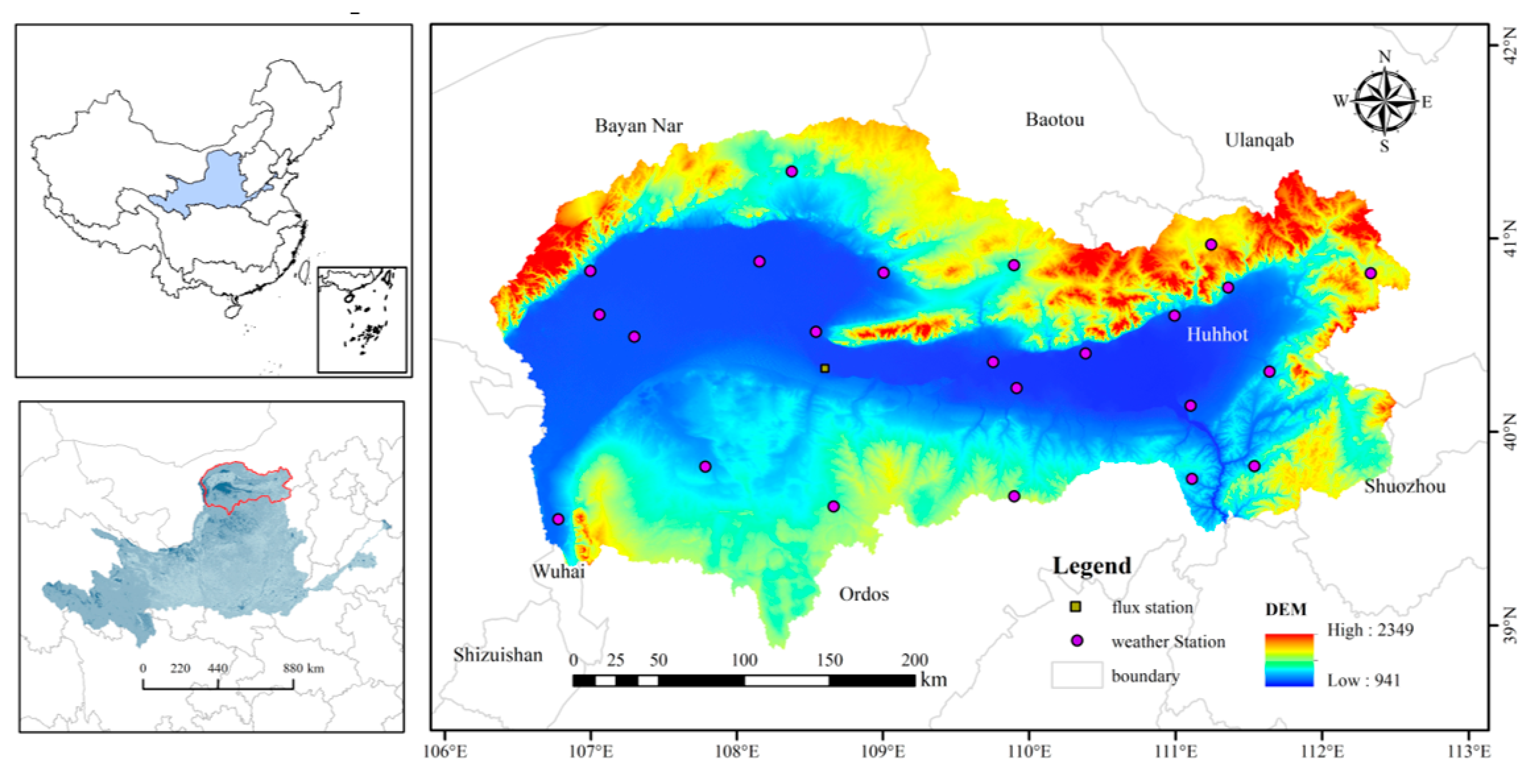
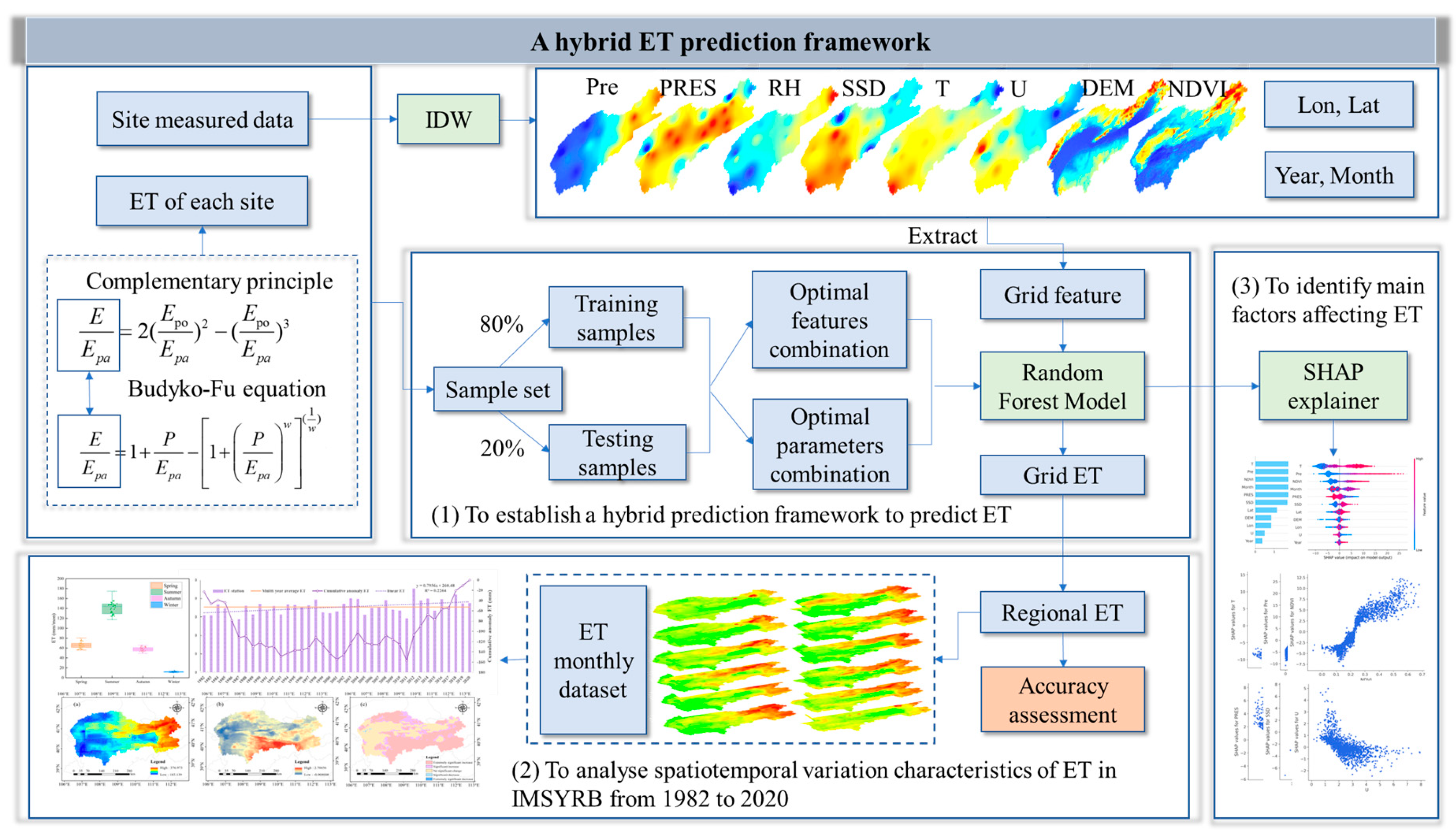
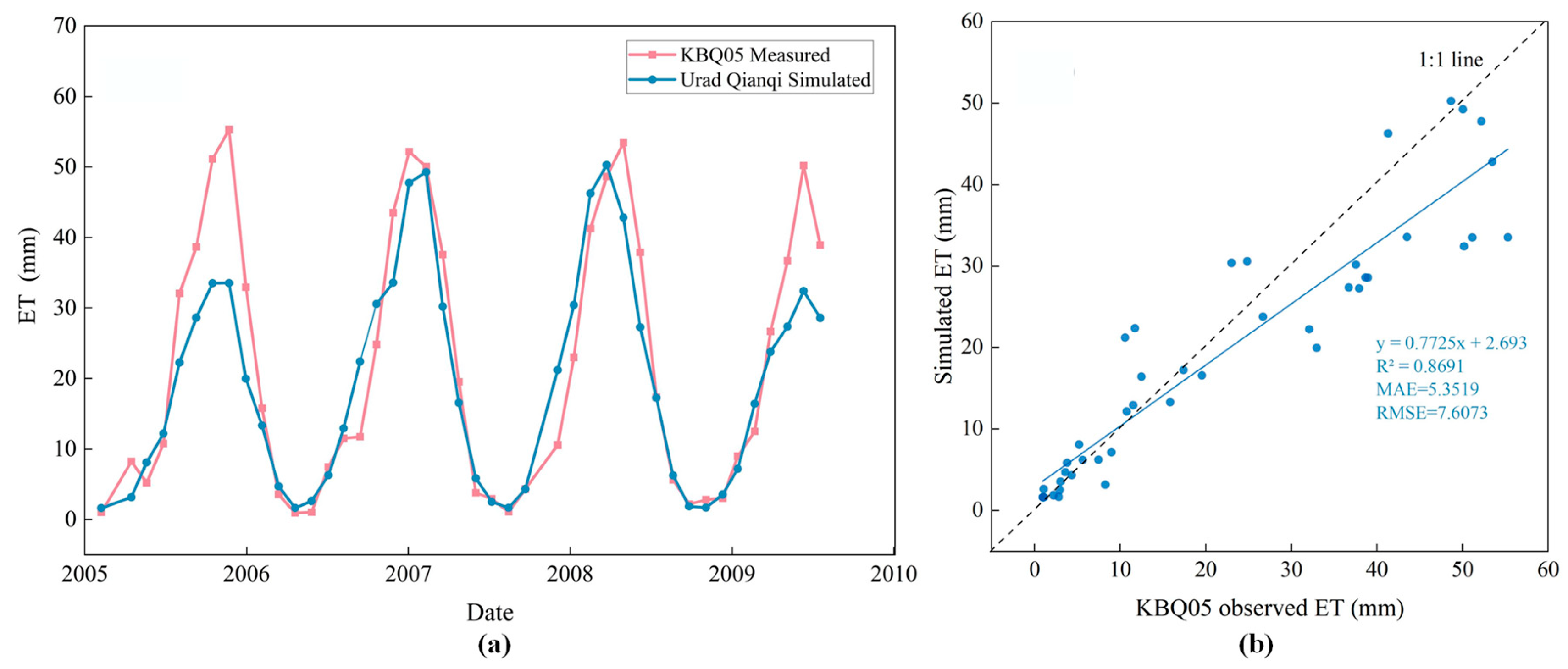
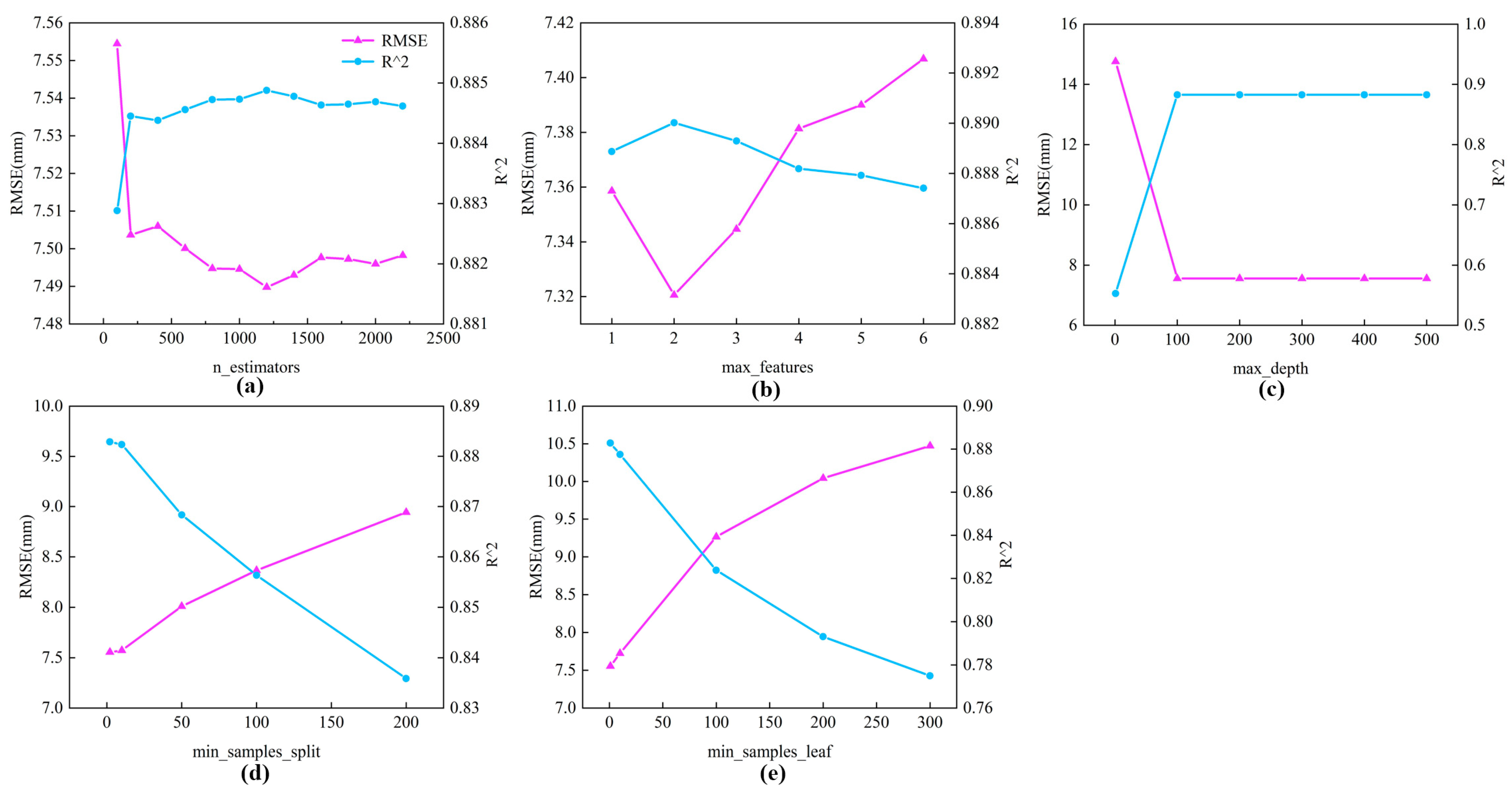
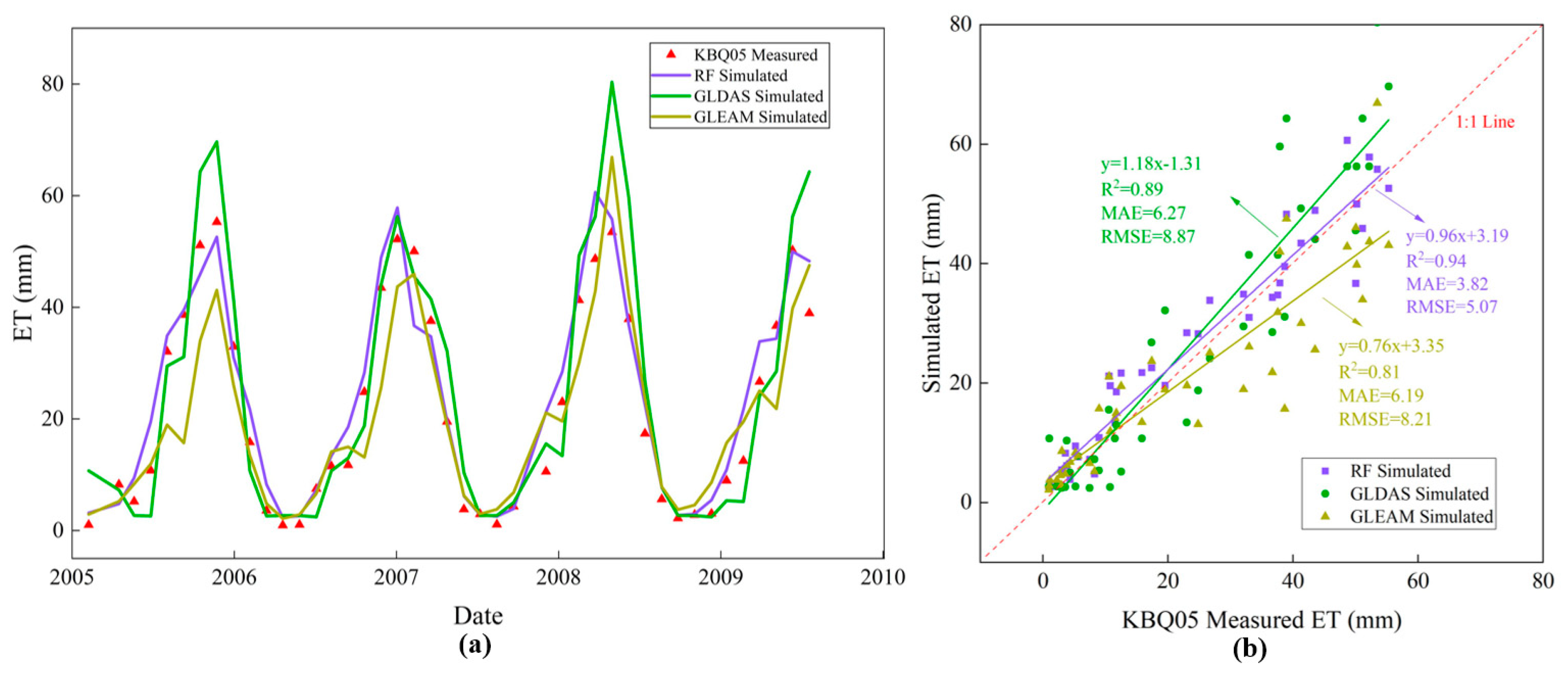
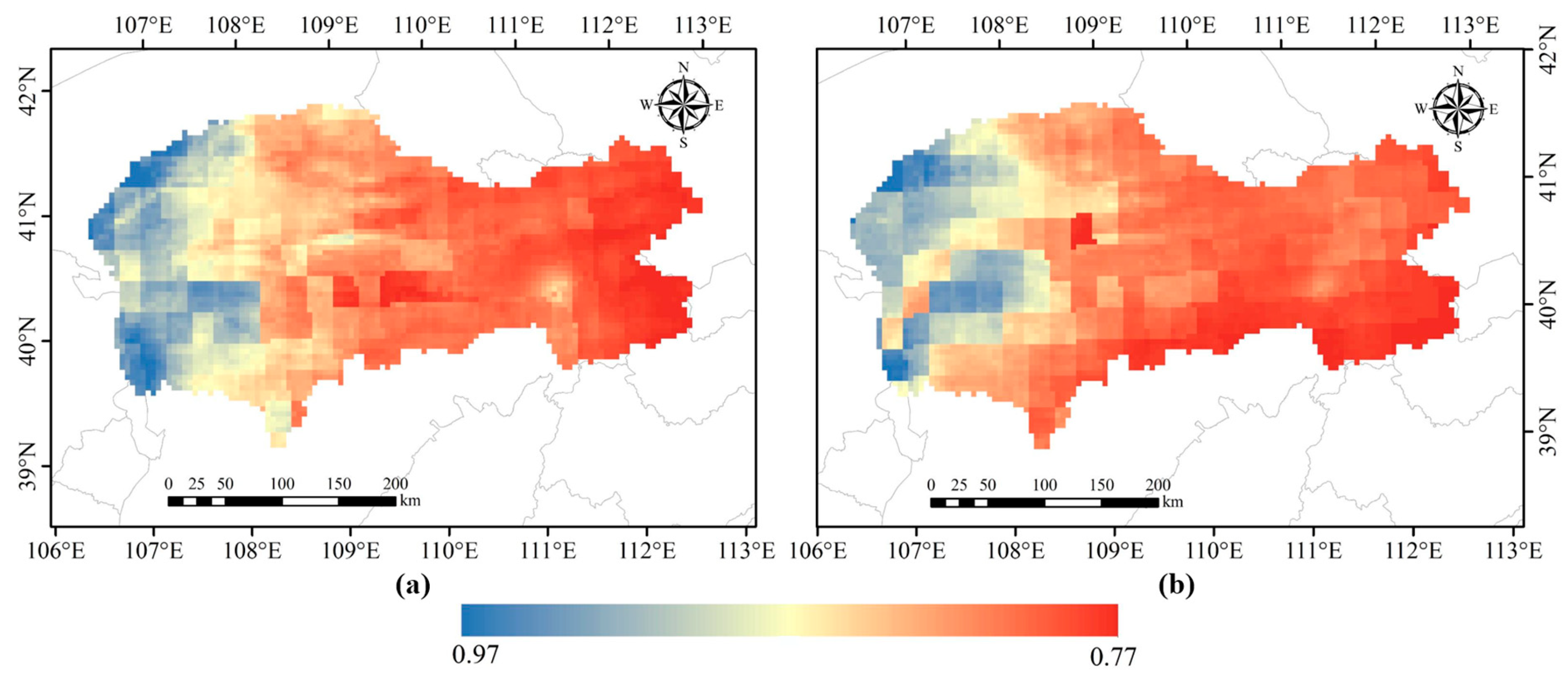
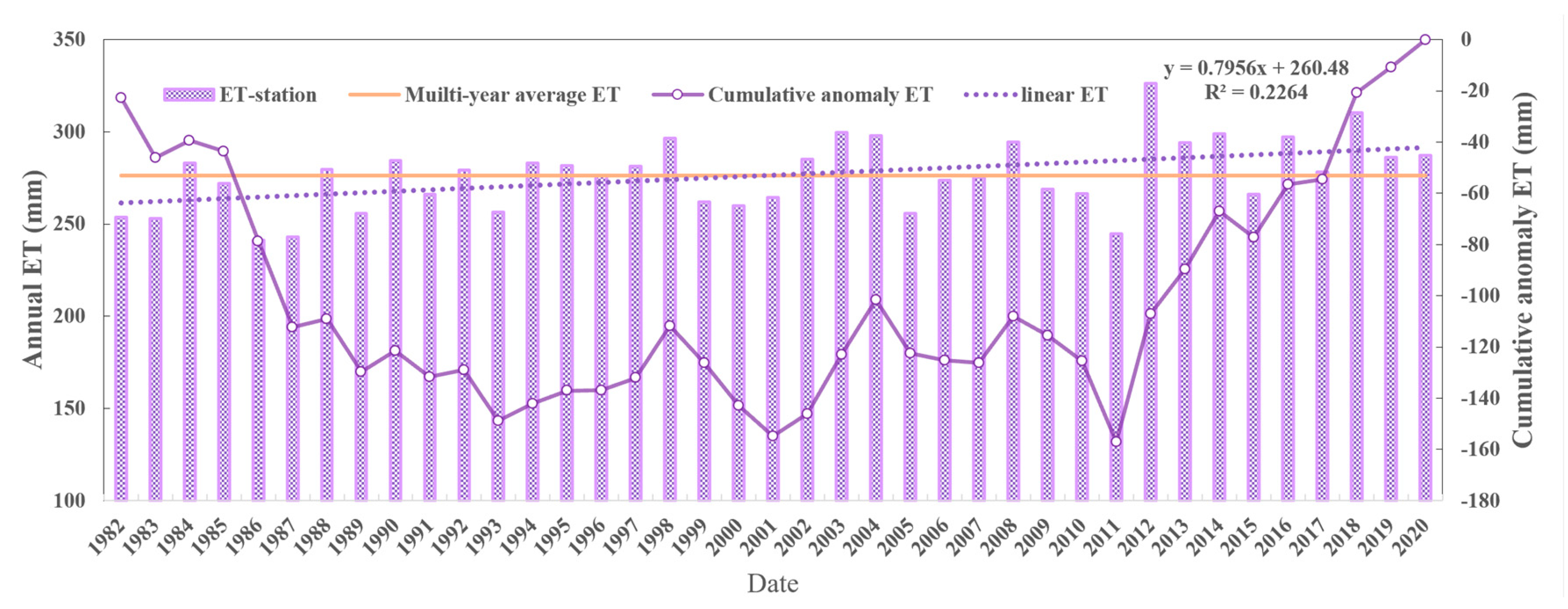
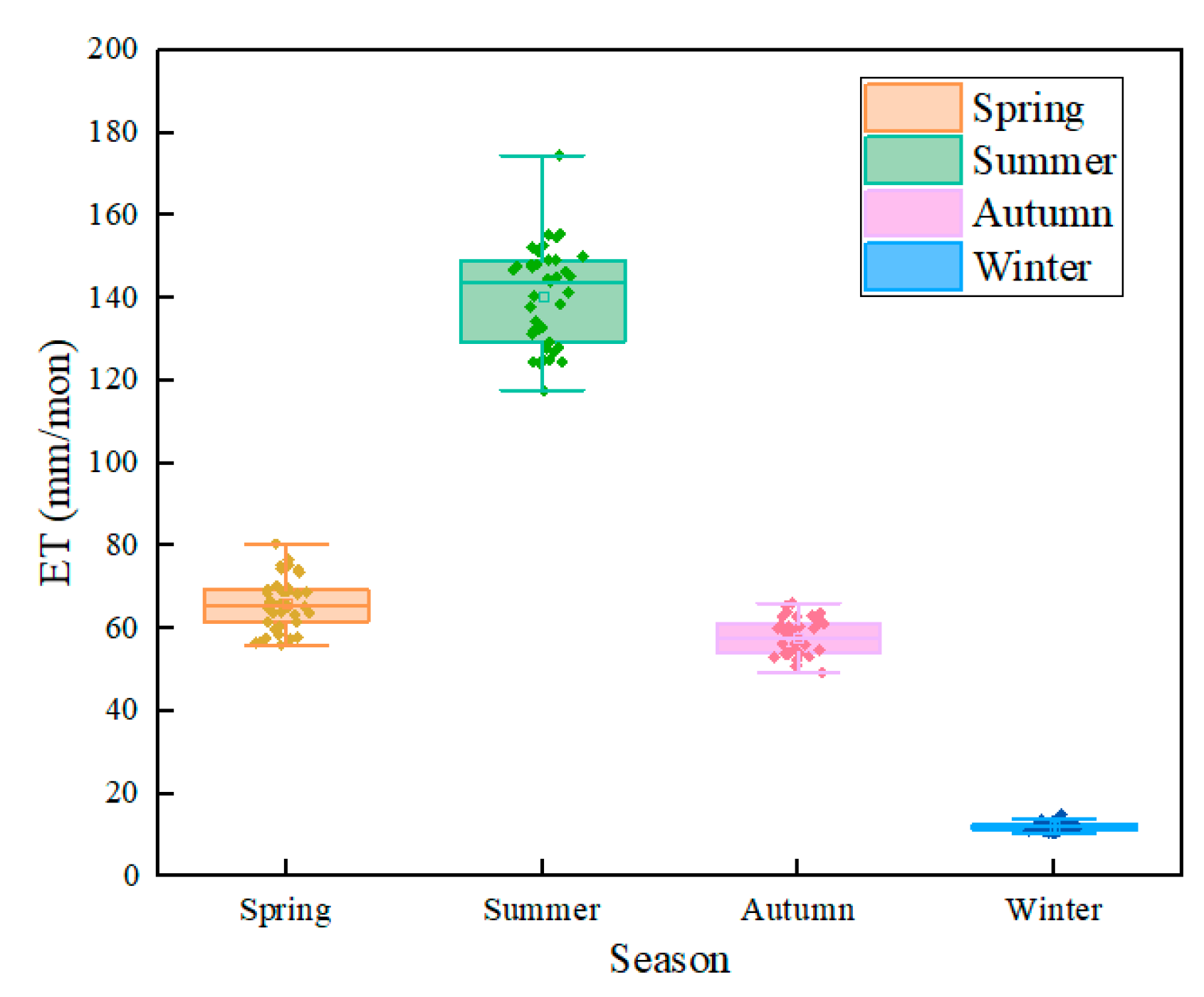

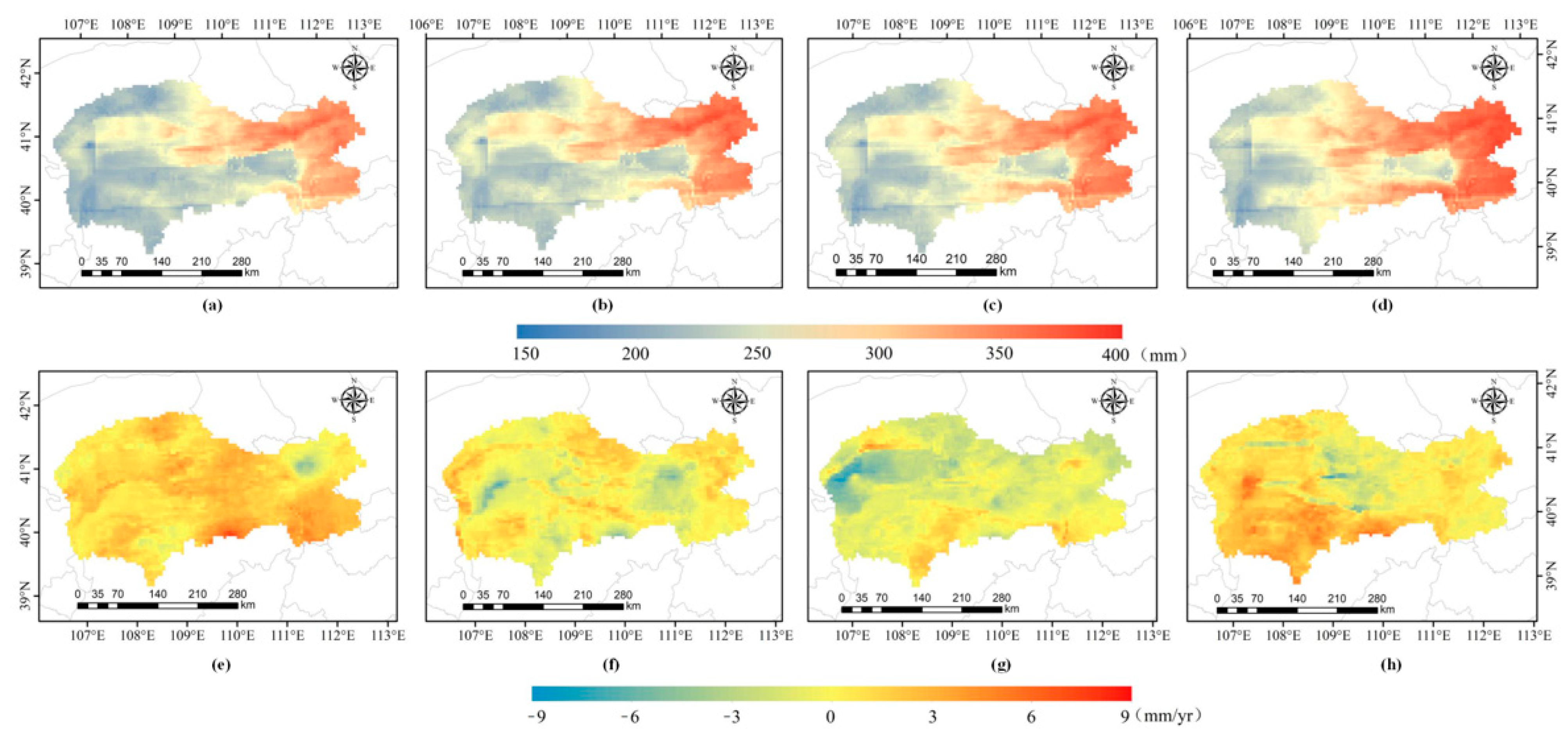
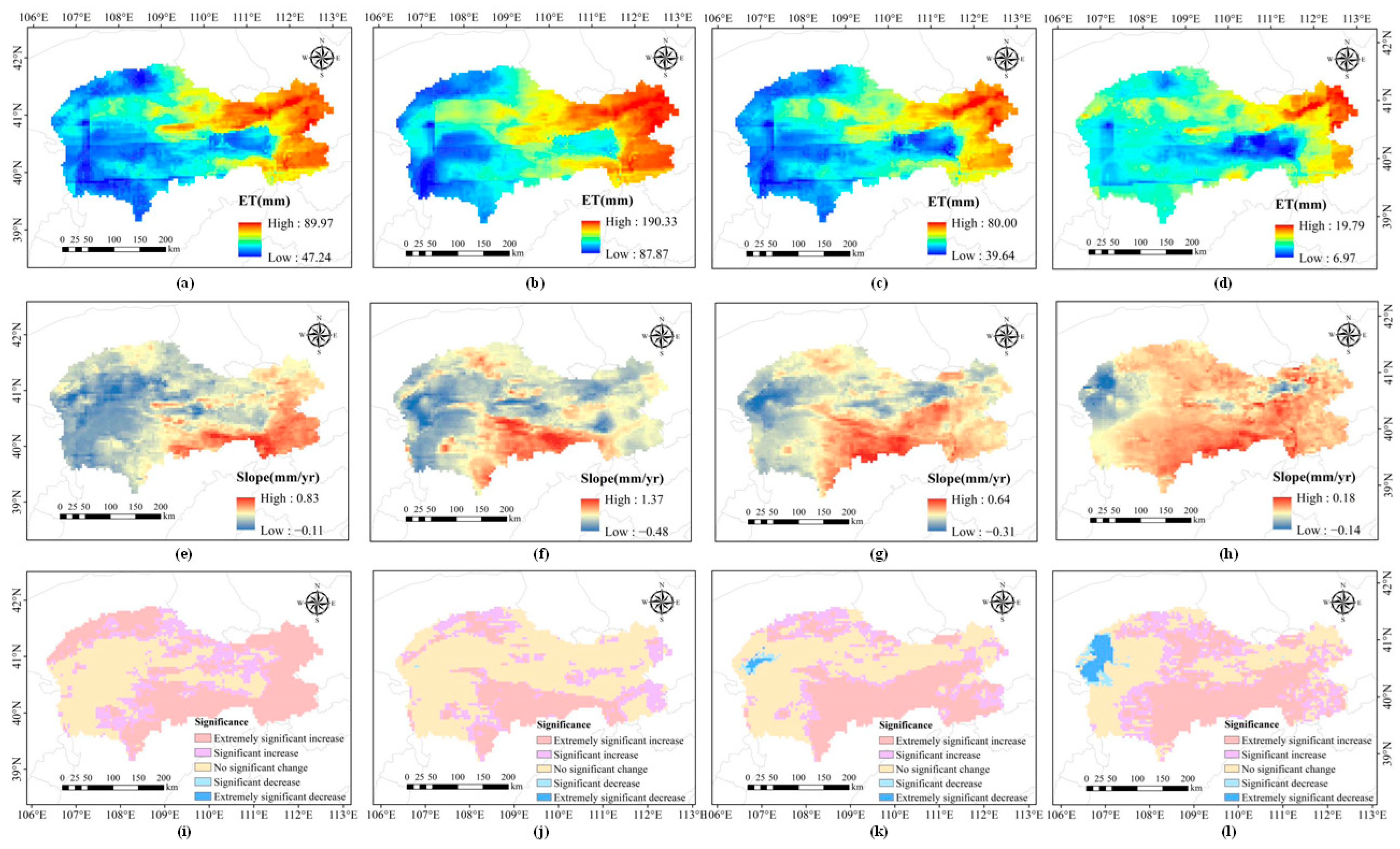
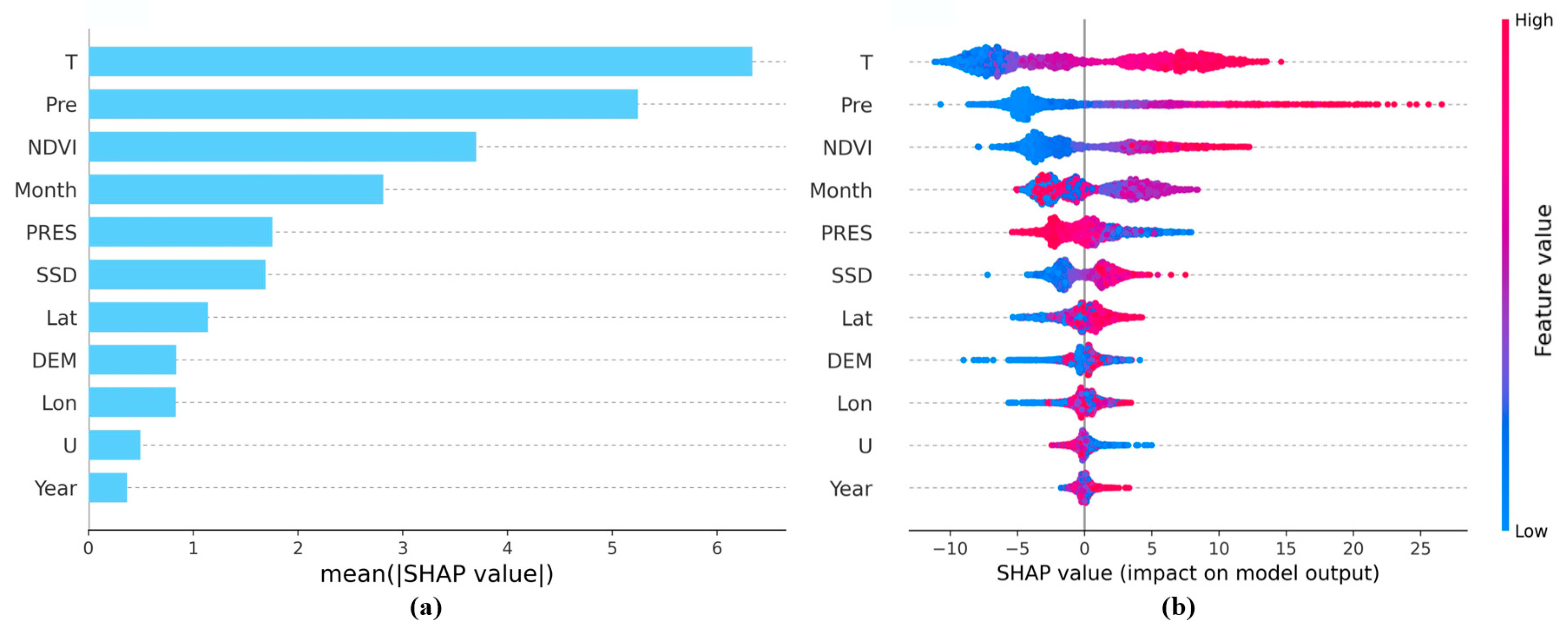

| Variable | Dataset Name | Time Range | Temporal Resolution | Spatial Resolution |
|---|---|---|---|---|
| DEM | China 1-km digital elevation map | 1982–2020 | - | 1 km |
| Pre, T, U, SSD, PRES | China daily surface climate dataset (V3.0) | 1982–2020 | Daily | - |
| NDVI | A 5-km-resolution dataset of the monthly NDVI product of China (1982–2020) | 1982–2020 | Monthly | 5 km |
| ET | Eddy covariance flux station data | 2006–2009 | 30 min | - |
| ET | GLEAM | 1982–2020 | Monthly | 0.25° × 0.25° |
| ET | GLDAS | 1982–2020 | Monthly | 0.25° × 0.25° |
| Standard of Classification | ET Variation Trend | Proportion (%) | |||||
|---|---|---|---|---|---|---|---|
| Slope | p | Annual | Spring | Summer | Autumn | Winter | |
| Slope > 0 | p < 0.01 | Extremely significant increase | 49.5 | 45.4 | 21.3 | 37.3 | 38.2 |
| 0.01 ≤ p < 0.05 | Significant increase | 14.5 | 19.1 | 16.8 | 16.4 | 20.4 | |
| p > 0.05 | No significant change | 35.8 | 35.5 | 61.9 | 44.9 | 36.3 | |
| Slope < 0 | 0.01 ≤ p <0.05 | Significant decrease | 0.2 | 0.0 | 0.0 | 0.9 | 1.7 |
| p < 0.01 | Extremely significant decrease | 0.0 | 0.0 | 0.00 | 0.6 | 3.4 | |
Disclaimer/Publisher’s Note: The statements, opinions and data contained in all publications are solely those of the individual author(s) and contributor(s) and not of MDPI and/or the editor(s). MDPI and/or the editor(s) disclaim responsibility for any injury to people or property resulting from any ideas, methods, instructions or products referred to in the content. |
© 2023 by the authors. Licensee MDPI, Basel, Switzerland. This article is an open access article distributed under the terms and conditions of the Creative Commons Attribution (CC BY) license (https://creativecommons.org/licenses/by/4.0/).
Share and Cite
Jiang, X.; Wang, G.; Wang, Y.; Yao, J.; Xue, B.; A, Y. A Hybrid Framework for Simulating Actual Evapotranspiration in Data-Deficient Areas: A Case Study of the Inner Mongolia Section of the Yellow River Basin. Remote Sens. 2023, 15, 2234. https://doi.org/10.3390/rs15092234
Jiang X, Wang G, Wang Y, Yao J, Xue B, A Y. A Hybrid Framework for Simulating Actual Evapotranspiration in Data-Deficient Areas: A Case Study of the Inner Mongolia Section of the Yellow River Basin. Remote Sensing. 2023; 15(9):2234. https://doi.org/10.3390/rs15092234
Chicago/Turabian StyleJiang, Xiaoman, Guoqiang Wang, Yuntao Wang, Jiping Yao, Baolin Xue, and Yinglan A. 2023. "A Hybrid Framework for Simulating Actual Evapotranspiration in Data-Deficient Areas: A Case Study of the Inner Mongolia Section of the Yellow River Basin" Remote Sensing 15, no. 9: 2234. https://doi.org/10.3390/rs15092234
APA StyleJiang, X., Wang, G., Wang, Y., Yao, J., Xue, B., & A, Y. (2023). A Hybrid Framework for Simulating Actual Evapotranspiration in Data-Deficient Areas: A Case Study of the Inner Mongolia Section of the Yellow River Basin. Remote Sensing, 15(9), 2234. https://doi.org/10.3390/rs15092234








